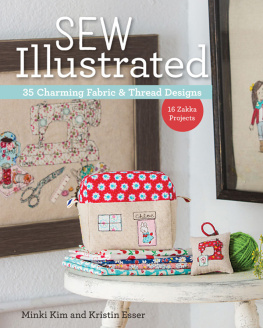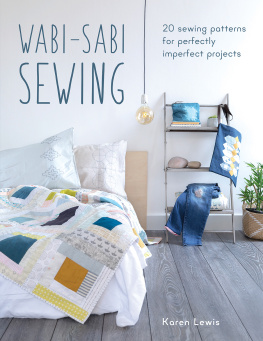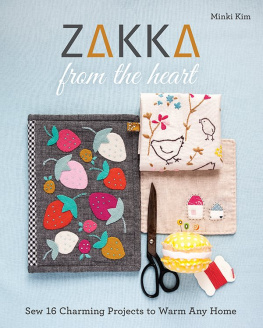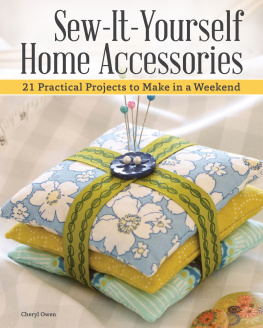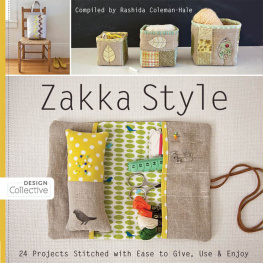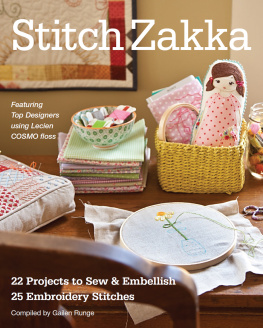ZAKKA
HANDMADES
Amy Morinaka


Copyright 2013 Creative Publishing international, Inc.
All rights reserved. No part of this work covered by the copyrights hereon may be reproduced or used in any form or by any meansgraphic, electronic, or mechanical, including photocopying, recording, taping of information on storage and retrieval systemswithout the written permission of the publisher. However, the publisher grants to the purchaser of this book permission to reproduce the templates in the book for personal use.
Due to differing conditions, materials, and skill levels, the publisher and various manufacturers disclaim any liability for unsatisfactory results or injury due to improper use of tools, materials, or information in this publication.
First published in the United States of America by
Creative Publishing international, Inc., a member of
Quayside Publishing Group
400 First Avenue North
Suite 400
Minneapolis, MN 55401
1-800-328-3895
www.creativepub.com
10 9 8 7 6 5 4 3 2 1
Digital Edition: 978-1-61058-732-7
Softcover Edition: 978-1-58923-750-6
Library of Congress Cataloging-in-Publication Data available
Resources
Eraser blocks for eraser stamp carving:
Kinokuniya Bookstores - www.kinokuniya.com/us/
Daiso - www.daisojapan.com/
Etsy.com - www.etsy.com/ (search for Japanese eraser blocks)
Rubber stamps:
Cavallini & Co. - www.cavallini.com/p-stamps-rubberstampsets.php
TPC Studio - www.tpcstudio.com/
Fabrics, notions, and supplies:
Momen Plus (Fabric store in Torrance, CA, that specializes in Japanese fabrics and sewing supplies) - www.momenplus.com
Etsy - www.etsy.com
Purl - www.purlsoho.com
Sew Mama Sew - www.sewmamasew.com
Joann Fabric and Craft Stores - www.joann.com
Nippori Textile Town (Fabric district near Nippori station, Tokyo, Japan) http://nippori-senigai.com
Technical Editor: Karen Manthey
Copy Editor: Catherine Broberg
Proofreader: Karen Ruth
Book Design: Laura H. Couallier, Laura Herrmann Design
Cover Design: Laura H. Couallier, Laura Herrmann Design
Illustrations: Amy Morinaka
Photographs: Glenn Scott Photography
CONTENTS
Acknowledgments
I am very grateful to Ms. Linda Neubauer, who is the acquisition editor of this book, for discovering me and giving me the opportunity to write this book. You have provided straight-forward information and supportive feedback to someone who had no idea how the book is published (me). Thank you, Linda!
Thank you from the bottom of my heart to everyone at Creative Publishing international for your amazing talents and efforts to make this book become reality.
Thank you to the continuing inspirations and warm feedback I receive from the online crafting and blogging community. I cant imagine my life without all of you talented, supportive, and kind folks out there to share my passion of crafting.
Thank you to Atsuko and Yuko for your encouragement and lasting friendship.
Thank you to my mom, my sisters, brothers, and my extended family members, for your love, support, and laughter.
Lastly, I am very thankful to my husband, Ben, for your understanding in my passion and obsession of crafting. Im so fortunate that I married a man who never complains (or even notices) about my ever growing inventory of fabric and yarn collection! And to my lovely girls, thank you for your pickiness that continues to fuel my creativity switch! I love you all.

T hank you for picking up this book! I am happy to share the joy of creating handmade zakka to add small happiness to your life. Growing up in Japan, I have always adored zakka, because Japan is a place packed with zakka! I now live in sunny California with my husband and two girls, and nothing is more fascinating than seeing how the world of handmade zakka is capturing the minds of crafters across the oceans.
So what is zakka? In Japanese, it refers to the small necessities of everyday life. It is a very broad term that includes accessories, stationery, fashion items, toys, home goods, kitchen items, small furniture, and much more. Zakka is not a form of art, but rather charming and practical items that are part of modern culture in Japan.
Handmade zakka is made by delicately combining natural fibers of 100 percent linen, cotton, and wool with small embellishments and meticulous handwork. Nature-inspired animals and flowers, houses and buildings, sewing notions, and characters from childrens booksthese are among the many motifs used to decorate zakka or to model the shapes of zakka. Many zakka designs are inspired by traditions and cultures from around the globe, including French country, Scandinavian natural style, Eastern European folk art, American vintage, and Asian ethnic, just to name a few.
In this book, I have combined my favorite handwork techniques of sewing, piecing patchwork, crocheting, embroidering, and carving eraser stamps to create original handmade zakka. Projects such as Sashiko-Style Coasters () are traditional Japanese handicrafts with the added flair of modern zakka.
Gift giving becomes very special when you personalize your handmade zakka. Hand-stitch babys initials or name to the Patchwork Bib () with gifts and use the Hangtag as a gift tag.
Regardless of your zakka-making experience, I hope you find inspiration in this book and enjoy making the projects. They are mostly small items that can be made by following the step-by-step instructions. But remember, there is really no right or wrong way to design and create your handmade zakkajust believe in yourself and create items that make you smile.

1
EVERYDAY ZAKKA
A dd simple pleasures to your life by creating zakka items that can be used every day. Create Fabric Buckets with Hangtags to organize your living space and Eraser Stamped Lavender Sachets for your clothes closet. Accessorize your fashions with Crochet-Edged One-Yard Scarf and Cotton Flower Bag Charm. Many of these zakka items can be made with small pieces of fabrics and suppliesmake them for your friends and family as thoughtful gifts and make them for yourself as well.


ERASER STAMPED LAVENDER SACHET
Finished Size:4 1/2" (11.4 cm) square, not including the hanging loop
A gently scented sachet filled with dried lavender is one of my favorite relaxing items. I embellished this sachet by stamping my hand-carved eraser stamps onto lightweight linen and framing it inside a coordinating fabric. Instead of carving your own stamp, use your favorite stamp from the local craft store. If you have difficulty stamping on linen, try using unbleached muslin instead. When stuffing dried lavender, be careful to avoid packing the lavender too firmly inside the sachet; keep it slightly loose so it will release the aroma when you squeeze it.


